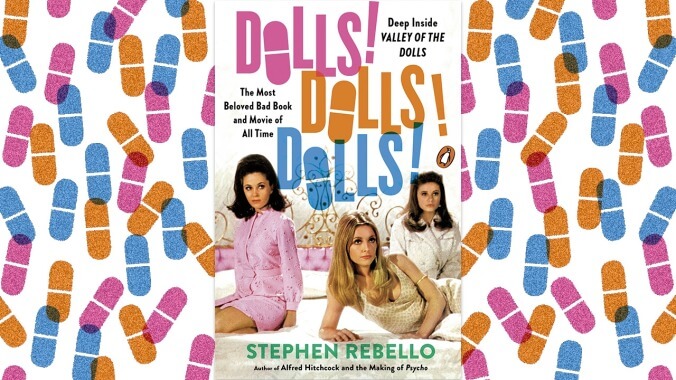In 1966, Jacqueline Susann’s fictional tell-all Valley Of The Dolls blew the lid off of showbiz gossip, following in the footsteps of compulsive page-turners like Grace Metalious’ Peyton Place and Harold Robbins’ The Carpetbaggers. Set against the backdrops of both Broadway and Hollywood, the salacious novel follows three aspiring starlets who all become famous, fall in love, and eventually succumb to the “doll”-popping that one of the book’s character’s calls “standard procedure” for show business. A curious public tore through the trashy tome, making it the biggest book of 1966 and a much-anticipated, but ultimately disastrous, movie the following year. Unabashed fan Stephen Rebello dives into this unforgettable legacy in Dolls! Dolls! Dolls! Deep Inside Valley Of The Dolls, The Most Beloved Bad Book And Movie Of All Time.
Rebello makes no excuses for the tawdriness of either the book or the film, but revels in it. Through detailed behind-the-scenes interviews and research, he brings the property to life in a book that is as compulsively readable as the original dishy source material.
Susann was a fiercely ambitious former bit player in Hollywood. When she couldn’t make it as an actress, she decided to use her experience to expose some of the industry’s seediest corners. It wasn’t difficult for readers to discern that the book’s steely Broadway veteran Helen Lawson had a lot in common with Ethel Merman, or that the unstable Neely O’Hara traveled a similar path as Judy Garland and Betty Hutton. Meanwhile, sexpot Jennifer North, worshipped for her body and longing for love, brought to mind similar glamorous actresses like Marilyn Monroe and Susann’s close friend Carole Landis.
Valley Of The Dolls was so popular that the moviemakers decided they didn’t need to spend a ton of money casting established stars. Chapter eight, “The Casting Of The Dolls—‘Not Since Scarlett O’Hara…’” is a fascinating exercise in imagining what Dolls could have been with different actors. A young Candice Bergen turned down the lead role of the cool, elegant model Anne Welles; Raquel Welch’s name was tossed around as a possibility for Jennifer; and Susann herself was pushing for Elvis Presley to play crooner Tony Polar (based on Dean Martin). In the end, Barbara Parkins, known for playing the bad girl of primetime soap Peyton Place; Patty Duke, a young Oscar winner who had just wrapped up her own eponymous sitcom; and the lovely, inexperienced Sharon Tate were cast as the movie’s leads.
If there is a villain in Rebello’s telling of the Valley Of The Dolls cinematic journey, it’s director Mark Robson, hired for his experience helming the movie version of the similarly scandalous Peyton Place. Robson kept his three young lead actresses on edge, most often clashing with the volatile Duke, who called him “the meanest son of a bitch I ever met in my life.” The director also appeared to go out of his way to be cruel to Tate, who was beloved by the rest of the cast and crew: “Duke recalled how she and Tate ‘were always making faces at Robson and giving the evil eye behind his back, but he had the last laugh. We were the ones who ended up looking ridiculous.’”
Dolls’ most disastrous performance was the one that never made it onscreen. The book’s most heartbreaking chapter covers the legendary Judy Garland’s short time on set, as Rebello describes an unsympathetic Robson as being ill-equipped to soothe the fragile actor’s nerves:
She kept waiting for her director to do what directors traditionally do—especially one dealing with an emotionally volatile diva who hadn’t faced a movie camera in four years—visit her dressing room, chat about the day’s work, and ease her onto a set where everyone else already knew one another and had established a rhythm.
With Garland inhabiting the role of a Broadway icon while playing opposite a fictionalized version of herself, her mental state rapidly took a turn for the worse, and the producers fired her only a few weeks in. “It was heartbreaking. She would have made the movie. She would have won an Academy Award,” Parkins says.
The script had also taken a chaotic journey through several writers and subsequent versions, leaving a scenery-chomping Duke to campily tear through now-famous lines like “I have to get up at five o’clock in the morning and ‘Sparkle, Neely, sparkle!’” Dolls!’ later chapters unfurl the players’ horrific reactions as they realize just how awful the final result was, with audiences howling through scenes like Anne’s glamor-girl modeling montage, or Neely’s many boozy breakdowns. At an early public screening, Susann leaped out of her seat and yelled, “They’ve ruined my book!” But for all its terrible reviews, Valley Of The Dolls was still a moneymaker, with many viewers likely curious to see just how bad the scandalous film really was.
Valley Of The Dolls was destined to achieve a different kind of success decades later, as the resilient film’s campiness was eventually embraced—especially by the gay community—and made into a cult classic. For fans eager to explore the most minute details of their favorite bad movie—dropped scenes from different screenplay drafts, and delicious gossipy details like the fact that Parkins would stare at a picture of Cat Stevens to get into a romantic mood before her love scenes—the book is a gift of a summer read, the kind to be indulgently plowed through, preferably with a champagne cocktail. And it’s not hard to imagine yet another depiction beyond this book—according to Dolls!, a movie about the making of Valley Of The Dolls would be a marked improvement on the original release.

